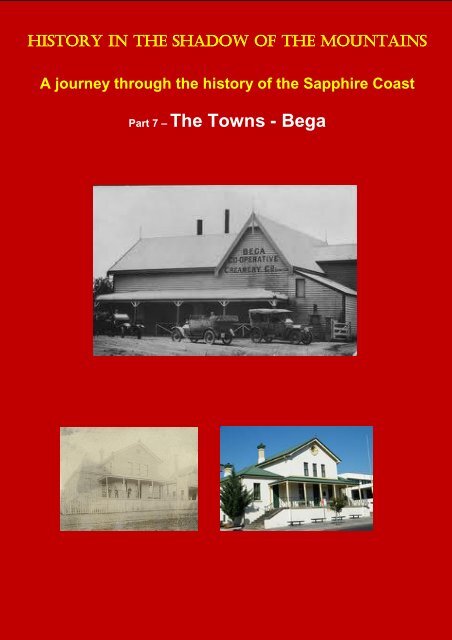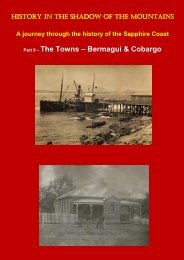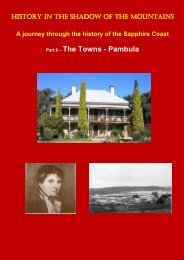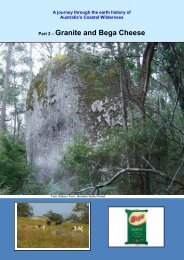A journey through the history of the Sapphire Coast
A journey through the history of the Sapphire Coast
A journey through the history of the Sapphire Coast
You also want an ePaper? Increase the reach of your titles
YUMPU automatically turns print PDFs into web optimized ePapers that Google loves.
HISTORY IN THE SHADOW OF THE MOUNTAINS<br />
A <strong>journey</strong> <strong>through</strong> <strong>the</strong> <strong>history</strong> <strong>of</strong> <strong>the</strong> <strong>Sapphire</strong> <strong>Coast</strong><br />
Part 7 – The Towns - Bega
Bega<br />
(Bega map on <strong>the</strong> last page)<br />
Bega at <strong>the</strong> turn <strong>of</strong> <strong>the</strong> 19 th century.<br />
Squatters moved into <strong>the</strong> Bega Valley from <strong>the</strong> inland areas <strong>of</strong> Monaro and<br />
Braidwood and staked out <strong>the</strong>ir grazing ‘runs’ in <strong>the</strong> early 1830s. Part 4 <strong>of</strong> this series<br />
describes <strong>the</strong>se events, including <strong>the</strong> 1834 arrival <strong>of</strong> <strong>the</strong> Imlay bro<strong>the</strong>rs, who<br />
acquired over 65,000 acres <strong>of</strong> runs and began permanent settlement <strong>of</strong> <strong>the</strong> area<br />
including <strong>the</strong> ‘Tarraganda’ run at ‘Biggah’.<br />
Government Surveyor Parkinson laid out a new town at what is now North Bega (on<br />
<strong>the</strong> site <strong>of</strong> <strong>the</strong> present Bega Cheese Factory). The origin <strong>of</strong> <strong>the</strong> name Bega is not<br />
definitive but is probably based on <strong>the</strong> Aboriginal word ‘Biggah’, which is thought to<br />
mean ‘big camping ground’ or ‘beautiful’.<br />
After a disastrous flood In May 1851 <strong>the</strong> town was moved to higher ground on <strong>the</strong><br />
sou<strong>the</strong>rn side <strong>of</strong> <strong>the</strong> river where it still stands today. In <strong>the</strong> first plan, <strong>the</strong> main street<br />
was Auckland Street, hence <strong>the</strong> construction <strong>of</strong> substantial buildings along that<br />
street. When <strong>the</strong> town centre moved Carp Street became <strong>the</strong> main street.<br />
The first town allotments were surveyed in February 1854 and sold at Eden in August<br />
<strong>of</strong> that year. Eden was <strong>the</strong> only port for communication and transport until Merimbula<br />
port was opened in 1855.<br />
In 1858 <strong>the</strong> Victoria Inn was opened in Auckland Street, and in 1859 <strong>the</strong> Family Hotel<br />
opened on <strong>the</strong> corner <strong>of</strong> Bega and Auckland Streets. Both buildings are still in<br />
existence, <strong>the</strong> Family Hotel is now <strong>the</strong> Bega Pioneers’ Museum. You can obtain from<br />
<strong>the</strong> Bega Pioneers’ Museum a pamphlet for a Bega Heritage Walk that contains a<br />
small map indicating several historic buildings and places. The buildings described<br />
below are just a sample <strong>of</strong> those you can see (http://museumb.freeiz.com ).
Bega Pioneers’ Museum<br />
By 1861 <strong>the</strong> population <strong>of</strong> Bega was 625 in 100 households. The Bega district was<br />
regarded as one <strong>of</strong> <strong>the</strong> few successful areas where land selections under <strong>the</strong> 1861<br />
Crown Lands Acts facilitated orderly settlement <strong>of</strong> <strong>the</strong> lands, with an average<br />
consolidated holding up to 500 acres.<br />
Under <strong>the</strong> Crown Lands Acts, anyone with a small deposit was able to take up Crown<br />
land and convert <strong>the</strong> title to freehold. Men and women with energy and<br />
entrepreneurship took up land in <strong>the</strong> Bega Valley and, with hard work, turned it into<br />
pr<strong>of</strong>itable farms. The ports <strong>of</strong> Tathra and Merimbula were relatively close to <strong>the</strong><br />
farms and this meant that produce could be shipped easily and quickly to Sydney,<br />
Melbourne and Tasmania.<br />
The operation <strong>of</strong> <strong>the</strong> Crown Land Acts is considered to be largely responsible for <strong>the</strong><br />
successful development <strong>of</strong> <strong>the</strong> dairy industry in <strong>the</strong> Bega Valley. This success is<br />
recorded in <strong>the</strong> Morris and Rankin Report to Parliament on <strong>the</strong> State <strong>of</strong> Public Land<br />
in New South Wales (1884) that said:<br />
Bega is one <strong>of</strong> <strong>the</strong> most prosperous districts in <strong>the</strong> colony, and its prosperity is mainly<br />
attributable to <strong>the</strong> fact <strong>of</strong> <strong>the</strong> land having been thrown open to <strong>the</strong> people. Rich land,<br />
mild climate, copious and regular rainfall, and last but not least, easy and cheap<br />
communication by water with <strong>the</strong> metropolis, all <strong>the</strong>se stamp it as a locality peculiarly<br />
adapted for homestead settlement, and upon which (<strong>the</strong>re can be no question) <strong>the</strong><br />
legislation <strong>of</strong> 1861 conferred incalculable benefit....’ Morris and Rankin Report to <strong>the</strong><br />
New South Wales Government in 1884.<br />
Dairy farming expanded quickly <strong>through</strong>out <strong>the</strong> 1860s, overtaking cattle farming as<br />
<strong>the</strong> predominant industry. In 1858, Tathra was used as a port for <strong>the</strong> transport <strong>of</strong><br />
products to Sydney, and <strong>the</strong> Illawarra Steam Company was established. In 1860, <strong>the</strong><br />
Tathra Wharf was constructed by <strong>the</strong> company, which allowed for <strong>the</strong> fur<strong>the</strong>r growth<br />
and expansion <strong>of</strong> <strong>the</strong> dairy industry.<br />
In <strong>the</strong> late 1890s <strong>the</strong> Bega Dairy Co-operative Limited was established. Bega is now<br />
well known for its cheese that is manufactured by <strong>the</strong> Bega Co-operative Society,<br />
one <strong>of</strong> <strong>the</strong> larger Australian cheese companies. ‘Bega Cheese’ is exported around<br />
<strong>the</strong> world and distributed across Australia and is available in most supermarkets and<br />
general stores. You can visit <strong>the</strong> Bega Co-operative and its Heritage Centre and<br />
Tourist Information service in North Bega, by turning <strong>of</strong>f <strong>the</strong> main highway at <strong>the</strong><br />
nor<strong>the</strong>rn end <strong>of</strong> <strong>the</strong> bridge.
Bega Co-operative Creamery in <strong>the</strong> 19 th century<br />
Notable examples <strong>of</strong> Bega’s built heritage<br />
An early picture <strong>of</strong> Bega Courthouse Bega Courthouse today<br />
Bega Courthouse<br />
The Bega Courthouse, erected in 1881, has a lengthy association with <strong>the</strong> town’s<br />
social <strong>history</strong> and a period <strong>of</strong> hectic and impressive building activity by <strong>the</strong> Public<br />
Works Department.<br />
Bega Courthouse is listed on <strong>the</strong> Register <strong>of</strong> <strong>the</strong> National Estate. With its double<br />
height central courtroom and smaller flanking <strong>of</strong>fice wings, Bega Courthouse<br />
illustrates <strong>the</strong> general form <strong>of</strong> courthouses in New South Wales during <strong>the</strong> greater<br />
part <strong>of</strong> <strong>the</strong> 19 th century. The scale <strong>of</strong> <strong>the</strong> building, with its prominent gabled façade,<br />
decorative railing and position at an intersection on Bega's main street, make a<br />
significant contribution to <strong>the</strong> streetscape.<br />
Bega Primary School Group<br />
The buildings <strong>of</strong> <strong>the</strong> Bega Primary School Group are Victorian Free Classical in style<br />
and are representative <strong>of</strong> public school buildings <strong>of</strong> <strong>the</strong> 1880s to1890s period. The<br />
group is listed on <strong>the</strong> Register <strong>of</strong> <strong>the</strong> National Estate.
In 1880 Bega residents petitioned for additions to be built at <strong>the</strong> town primary school<br />
to overcome <strong>the</strong> overcrowding. In fact a new building was approved - <strong>the</strong> present<br />
sou<strong>the</strong>rn building facing Auckland Street. The buildings were occupied by January<br />
1892 and finally completed in September that year. A belltower stands above <strong>the</strong><br />
central entrance. The infants’ building, added later, has a gabled wing similar to that<br />
on <strong>the</strong> 1882-83 building and is also built <strong>of</strong> brick. It has relatively little decoration and<br />
is T-shaped in plan. The residence is stuccoed and painted.<br />
Former Commercial Banking Company building<br />
The Commercial Banking Company (CBC) <strong>of</strong> Sydney building was erected in 1865.<br />
It is understood to have been <strong>the</strong> first bank in Bega, <strong>the</strong> first two-storey building, and<br />
<strong>the</strong> third building <strong>of</strong> substance in <strong>the</strong> town. It is a simple mid-Victorian Colonial style<br />
commercial building constructed <strong>of</strong> English bond brickwork on coursed rubble<br />
bluestone foundation. The building occupies a commanding position at <strong>the</strong> edge <strong>of</strong> a<br />
bluff on Auckland Street that was originally <strong>the</strong> main town street. The building is<br />
listed on <strong>the</strong> NSW State Heritage Register.<br />
Former jeweller’s shopfront<br />
Former CBC building<br />
The former jeweller’s shopfront at 165 Carp Street, dating from about 1899, is an<br />
elaborate and intact example <strong>of</strong> <strong>the</strong> late Victorian shop fitter's art. As such, it is listed<br />
on <strong>the</strong> Register <strong>of</strong> <strong>the</strong> National Estate.<br />
Originally single storey, it was rebuilt as a two-storey building in 1904. The shop has<br />
two curved shop windows with panelled timber stallboards <strong>of</strong> grained oak, a central<br />
door (originally surmounted by a fanlight which has now been partly replaced by a<br />
clock) and a chequered marble floor entrance. Decoration to <strong>the</strong> windows includes
gold painting; <strong>the</strong> shop name is painted in gold on <strong>the</strong> door and at least one window.<br />
There is also a curtain type <strong>of</strong> decoration to <strong>the</strong> upper parts <strong>of</strong> <strong>the</strong> windows. You can<br />
still see where iron grille fences for security were drawn across <strong>the</strong> entrance each<br />
night.<br />
Jewellers’ shopfront in Carp Street











